Shannon Peters Clinic at Traumhof
This is going to get long, pictures and video are included.
The clinic was held at a stable in Carnation, WA called Traumhof. Their website informs me that it stands for 'Dream Farm'. The farm itself was pretty swanky (in my experience, I'm sure it could be swankier). They had limited turnout (booo), amazing huge stalls (yaaay), a square indoor (for lunging, I presume) and a really nice, state of the art covered arena with really awesome footing.
Victoria and I arrived after the clinic had started, but she had seen the first rider at clinics before and didn't care to see the woman ride again. After watching what little I did see, I can't blame her. This particular rider, who runs a dressage training barn somewhere else in WA, was rigid. Her hands never moved, much to the frustration of her very pretty warmblood. She also never really let him stretch out his back and you could SEE the horse trying to ask for a stretch.
A lot of what I heard is no different from what I hear at home, either in my own lessons, or auditing other lessons that J gives at the barn. Let the horse out and stretch, you want their back to round on their own. So while I think it was a worthwhile 35$ to audit this clinic, I had a hard time seeing what was so different in message that these riders were paying for their ride time. It was a very simple message that they seemed to overlook quite frequently. It just seems crazy to me that these riders were ignoring basics that could incredibly strengthen their advanced horses in favor of schooling the advanced movement over and over again to try and fix what was wrong.
It's a lot of what I do with my horse, it's what I've been taught, and am currently being taught by J. Granted, our basics are still a bit further behind these horses, but the concept is still sound.
Some general notes that I made, in no particular order...
-You want 2-4 strides of collected walk before your transition to collected trot
-Use the hips, back and belly will fix the front of the horse. Do NOT use your hands! This mantra was repeated for nearly every rider that day
-You want to teach the horse how to use his hips, do not use hands (!!) Use renvers and haunches in to help teach the horse how to carry the shoulders up and butt underneath him. It gets his legs more under his body so he has to change his balance.
- The horse has to stay ON your seat, not in front or behind it, LIGHT HANDS!
-Flying Changes: Do a canter to walk transition while staying on the horse's hindquarters, go immediately to haunches in at a walk, then back to canter
For many of these horses, the riders requested help with upper level movements, but what they worked on was a lot of basic lateral work that's the precursor to the upper level movements. So instead of doing a canter pirouette, they worked on haunches-in walking down the long side, doing a canter transition into a volte and heading down the long diagonal. The goal being to collect and balance the horse by having the horse do most of the work, not the rider.
I don't remember who this guy is, and I'm kicking myself (I also didn't video every rider so I can't use order of elimination. What I do remember, is that his rider is from Shelburne Farm and trains under Siggi Wolff with Cavallis.
This pretty guy is an 8 year old Polish Arabian stallion, National Champion at 2nd and 3rd Level dressage. Currently showing 3rd Level and schooling 4th. Again, we were hearing a lot of "let his nose come out and down toward the dirt" and it felt like the riders were not quite picking up on that.
This Hanoverian mare (by Fabuleux/Rubenstein/Weltmeyer) was 5 1/2 years old, same as Gwyn, and had competed at the FEI 5 year old level and First Level, scoring 75%. They were aiming for FEI-6 year old tests next summer but were nowhere near that level. She had a lot of baby moments and Peters was very adamant that her baby behavior had to go by the time she was 5-6 years old. You want to get the horse thinking to distract them from things that otherwise might cause flight response. If she wants to look or stiffen, move her away with the leg.
Basically, you want the aids and her response to be consistent every day and immediate. Even if you get an incorrect response, you want that response, because it means the horse is trying. The horse is allowed to make mistakes, the horse is NOT allowed to ignore the rider. They did a lot of lateral work, shoulder in, haunches in, renvers. You're challenging the horse, asking it to do the next step in work and seeing if they step up and try and meet the challenge.
With the young horses, you want them to accept weight on their back, which will help with canter transitions. They did a lot of work on those transitions, basically asking the horse to halt, back up, take a few walk steps forward then go directly into the canter with the goal being that the horse would become more responsive to the aids and reactive in a positive way.
Horse: 7 year old German Oldenburg gelding. Schooling 4th level and Prix St. George. Competed at NAJYRC. This girl is a freshman at U. of Washington and she's planning on qualifying for the Young Rider team in 2013. She was also one of my more favorite riders of the day, a bit more forgiving with her hands. However, I'm not sure what her horse was doing in the canter, you can see it in the video. He was very much like a see saw, and I'm not sure if that has to do with the speed at which they were traveling, or his normal gait. I can say that he still had the see saw action when he was moving more forward, and when she was warming him up.
Pictures:
Mind, I had a cheap-o digital camera that didn't do well with the gray, rainy day and dim lighting. So most of these are terrible. The videos are of a far better quality for seeing the horse and rider.



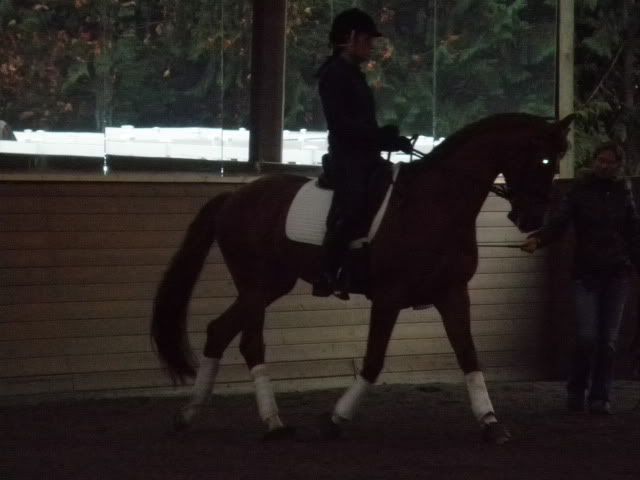
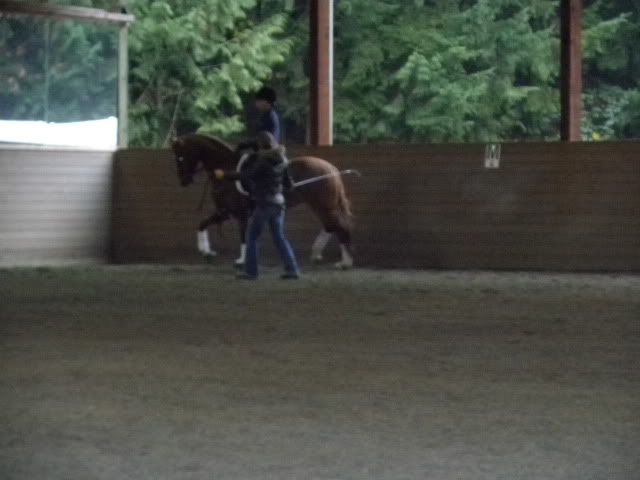
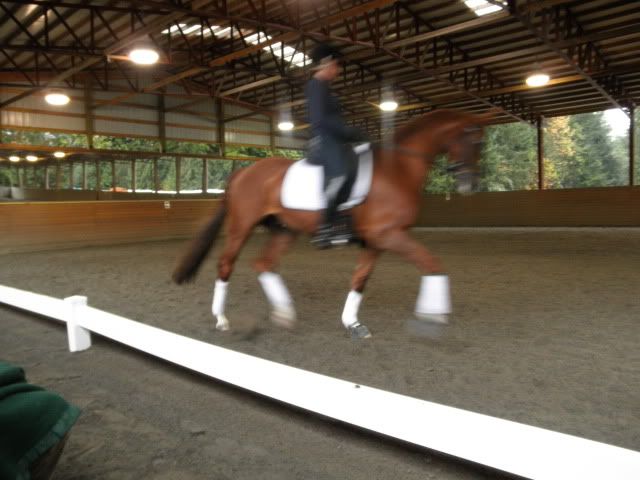
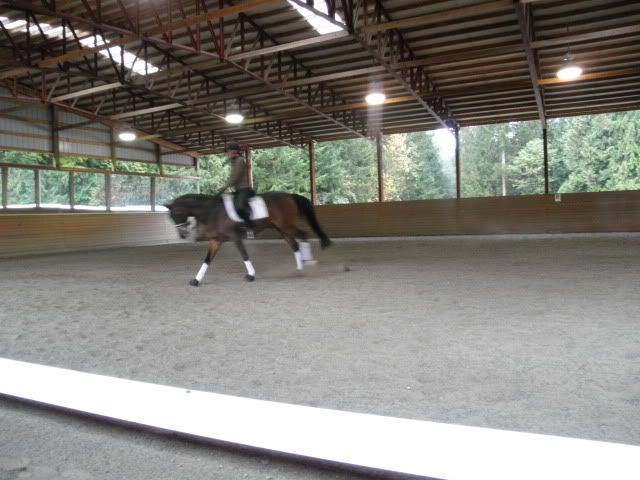
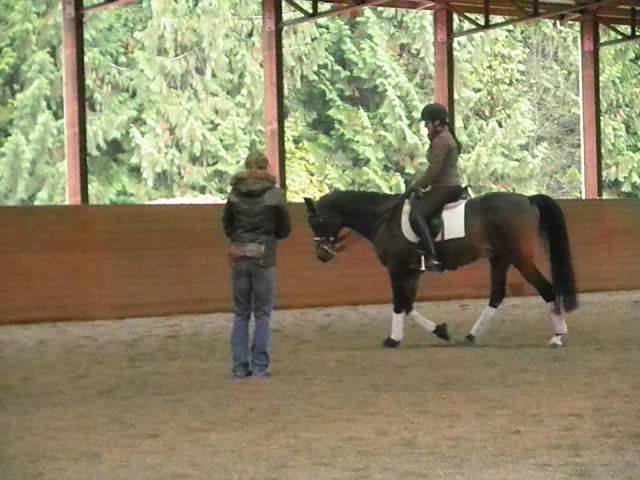

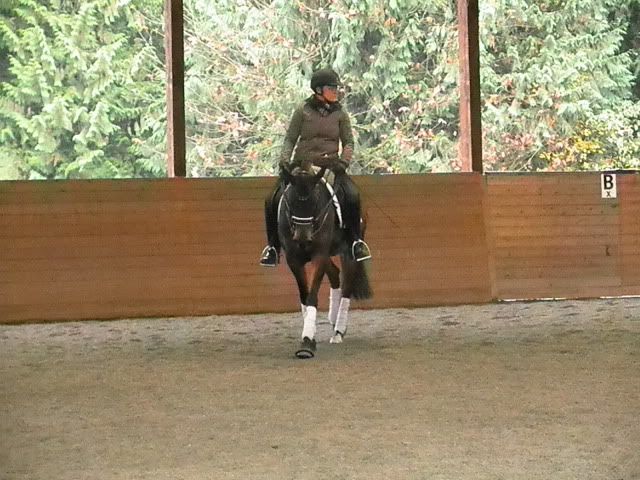




This entry is public.
The clinic was held at a stable in Carnation, WA called Traumhof. Their website informs me that it stands for 'Dream Farm'. The farm itself was pretty swanky (in my experience, I'm sure it could be swankier). They had limited turnout (booo), amazing huge stalls (yaaay), a square indoor (for lunging, I presume) and a really nice, state of the art covered arena with really awesome footing.
Victoria and I arrived after the clinic had started, but she had seen the first rider at clinics before and didn't care to see the woman ride again. After watching what little I did see, I can't blame her. This particular rider, who runs a dressage training barn somewhere else in WA, was rigid. Her hands never moved, much to the frustration of her very pretty warmblood. She also never really let him stretch out his back and you could SEE the horse trying to ask for a stretch.
A lot of what I heard is no different from what I hear at home, either in my own lessons, or auditing other lessons that J gives at the barn. Let the horse out and stretch, you want their back to round on their own. So while I think it was a worthwhile 35$ to audit this clinic, I had a hard time seeing what was so different in message that these riders were paying for their ride time. It was a very simple message that they seemed to overlook quite frequently. It just seems crazy to me that these riders were ignoring basics that could incredibly strengthen their advanced horses in favor of schooling the advanced movement over and over again to try and fix what was wrong.
It's a lot of what I do with my horse, it's what I've been taught, and am currently being taught by J. Granted, our basics are still a bit further behind these horses, but the concept is still sound.
Some general notes that I made, in no particular order...
-You want 2-4 strides of collected walk before your transition to collected trot
-Use the hips, back and belly will fix the front of the horse. Do NOT use your hands! This mantra was repeated for nearly every rider that day
-You want to teach the horse how to use his hips, do not use hands (!!) Use renvers and haunches in to help teach the horse how to carry the shoulders up and butt underneath him. It gets his legs more under his body so he has to change his balance.
- The horse has to stay ON your seat, not in front or behind it, LIGHT HANDS!
-Flying Changes: Do a canter to walk transition while staying on the horse's hindquarters, go immediately to haunches in at a walk, then back to canter
For many of these horses, the riders requested help with upper level movements, but what they worked on was a lot of basic lateral work that's the precursor to the upper level movements. So instead of doing a canter pirouette, they worked on haunches-in walking down the long side, doing a canter transition into a volte and heading down the long diagonal. The goal being to collect and balance the horse by having the horse do most of the work, not the rider.
I don't remember who this guy is, and I'm kicking myself (I also didn't video every rider so I can't use order of elimination. What I do remember, is that his rider is from Shelburne Farm and trains under Siggi Wolff with Cavallis.
This pretty guy is an 8 year old Polish Arabian stallion, National Champion at 2nd and 3rd Level dressage. Currently showing 3rd Level and schooling 4th. Again, we were hearing a lot of "let his nose come out and down toward the dirt" and it felt like the riders were not quite picking up on that.
This Hanoverian mare (by Fabuleux/Rubenstein/Weltmeyer) was 5 1/2 years old, same as Gwyn, and had competed at the FEI 5 year old level and First Level, scoring 75%. They were aiming for FEI-6 year old tests next summer but were nowhere near that level. She had a lot of baby moments and Peters was very adamant that her baby behavior had to go by the time she was 5-6 years old. You want to get the horse thinking to distract them from things that otherwise might cause flight response. If she wants to look or stiffen, move her away with the leg.
Basically, you want the aids and her response to be consistent every day and immediate. Even if you get an incorrect response, you want that response, because it means the horse is trying. The horse is allowed to make mistakes, the horse is NOT allowed to ignore the rider. They did a lot of lateral work, shoulder in, haunches in, renvers. You're challenging the horse, asking it to do the next step in work and seeing if they step up and try and meet the challenge.
With the young horses, you want them to accept weight on their back, which will help with canter transitions. They did a lot of work on those transitions, basically asking the horse to halt, back up, take a few walk steps forward then go directly into the canter with the goal being that the horse would become more responsive to the aids and reactive in a positive way.
Horse: 7 year old German Oldenburg gelding. Schooling 4th level and Prix St. George. Competed at NAJYRC. This girl is a freshman at U. of Washington and she's planning on qualifying for the Young Rider team in 2013. She was also one of my more favorite riders of the day, a bit more forgiving with her hands. However, I'm not sure what her horse was doing in the canter, you can see it in the video. He was very much like a see saw, and I'm not sure if that has to do with the speed at which they were traveling, or his normal gait. I can say that he still had the see saw action when he was moving more forward, and when she was warming him up.
Pictures:
Mind, I had a cheap-o digital camera that didn't do well with the gray, rainy day and dim lighting. So most of these are terrible. The videos are of a far better quality for seeing the horse and rider.














This entry is public.